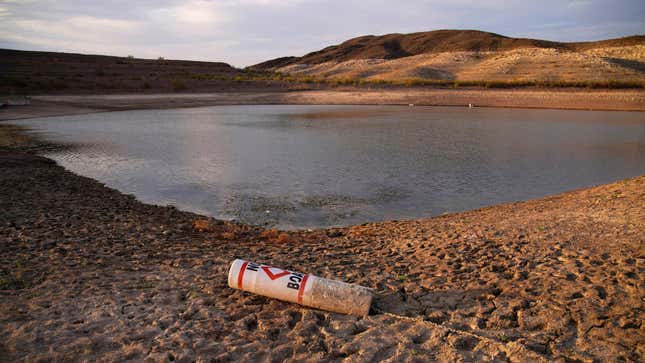
As spring kicks into full swing, federal officials are dealing with an increasing water crisis in the parched U.S. West. The federal government said this week that it was facing the tough decision of rationing water between two of the largest reservoirs in the country, choosing between keeping the lights on for millions of people—or reducing water deliveries for states in the South.
Lake Powell, the second-largest reservoir in the U.S., has been slinking towards apocalyptic levels over the past year, hitting record low after record low. As of Friday, Lake Powell was sitting at 3,523 feet above sea level, its lowest level on record. While spring snowmelt could raise the levels, officials say the snow is already melting, and the region’s prolonged drought—the worst in 1,200 years—is making water levels even lower.
“The best available science indicates that the effects of climate change will continue to adversely impact the basin,” Tanya Trujillo, the Assistant Secretary for Water and Science at the Department of the Interior, told seven states in a letter sent this week.
This is troubling not only for water supply and as a deeply concerning signal of climate change but is also bad news for the Glen Canyon Dam, which provides electricity for some 5.8 million households and businesses across Western states. The dam needs at least 3,490 feet of water to run; last month, water levels surpassed a buffer level that signaled to the federal government that it needs to do something, and quick, to keep the dam operational. Thousands of people in nearby cities would also lose access to water if levels dip below that marker.
One of the strategies the government is considering is simply to keep more water in Lake Powell. The government has asked Western states that rely on water from the Colorado River to provide feedback on a plan by April 22 that would keep 480,000 acre-feet of water—enough to supply about a million households—in Lake Powell, rather than releasing it downstream to Lake Mead, another crucial reservoir.
Each year, Lake Powell releases 8.23 million acre-feet of water into Lake Mead, which provides water for Arizona, Nevada, and part of Mexico, as well as generating electricity from the Hoover Dam for parts of Arizona, California, and Nevada. On Friday, Lake Mead sat at 1,058.39 feet above sea level—part of its own months-long record-breaking streak of hitting its lowest levels on record. Keeping water in Lake Powell could mean that the water in Lake Mead would stay lower than usual through the spring melting season. (Low levels in Lake Powell could also mean that the mechanisms for making these releases would be impacted.)
The Hoover Dam can still generate electricity when levels are between 925 and 950 feet, Trujillo told the Arizona Star. But we’re dealing with uncertain territory when it comes to how states could be affected by these potential cuts.
“We’re in crisis management, and health and human safety issues, including production of hydropower, are taking precedence,” Jack Schmidt, director of the center for Colorado River Studies at Utah State University, told the AP. “Concepts like, ‘Are we going to get our water back’ just may not even be relevant anymore.”